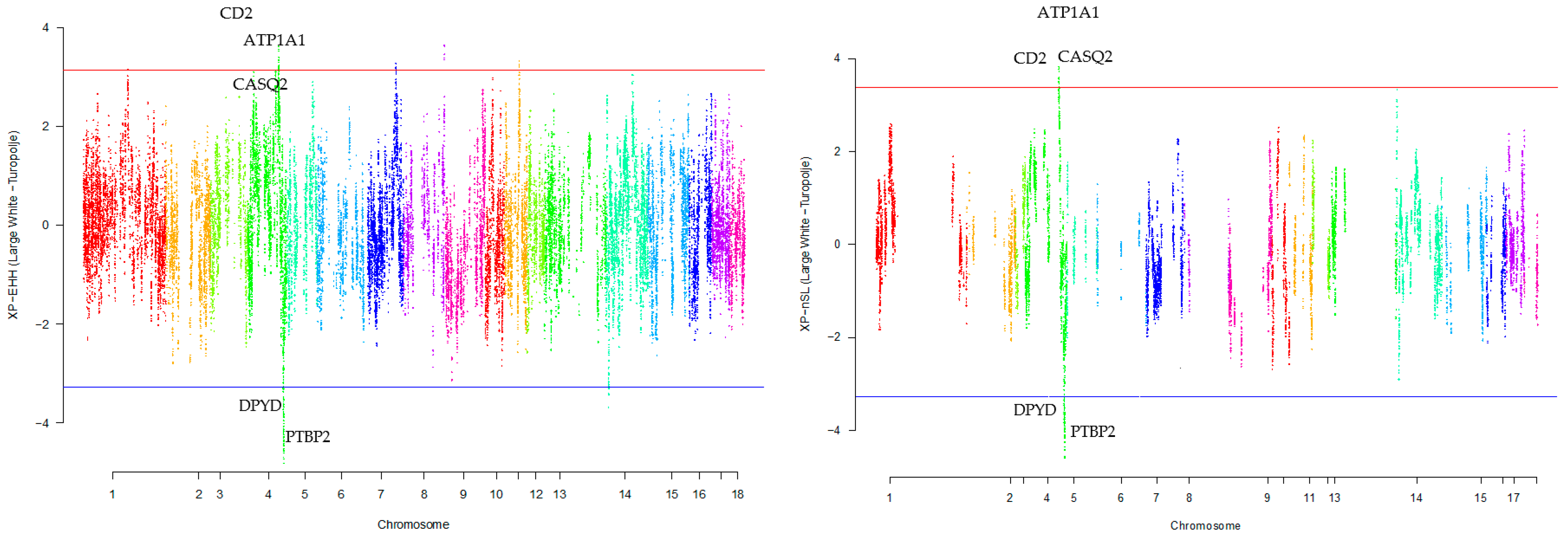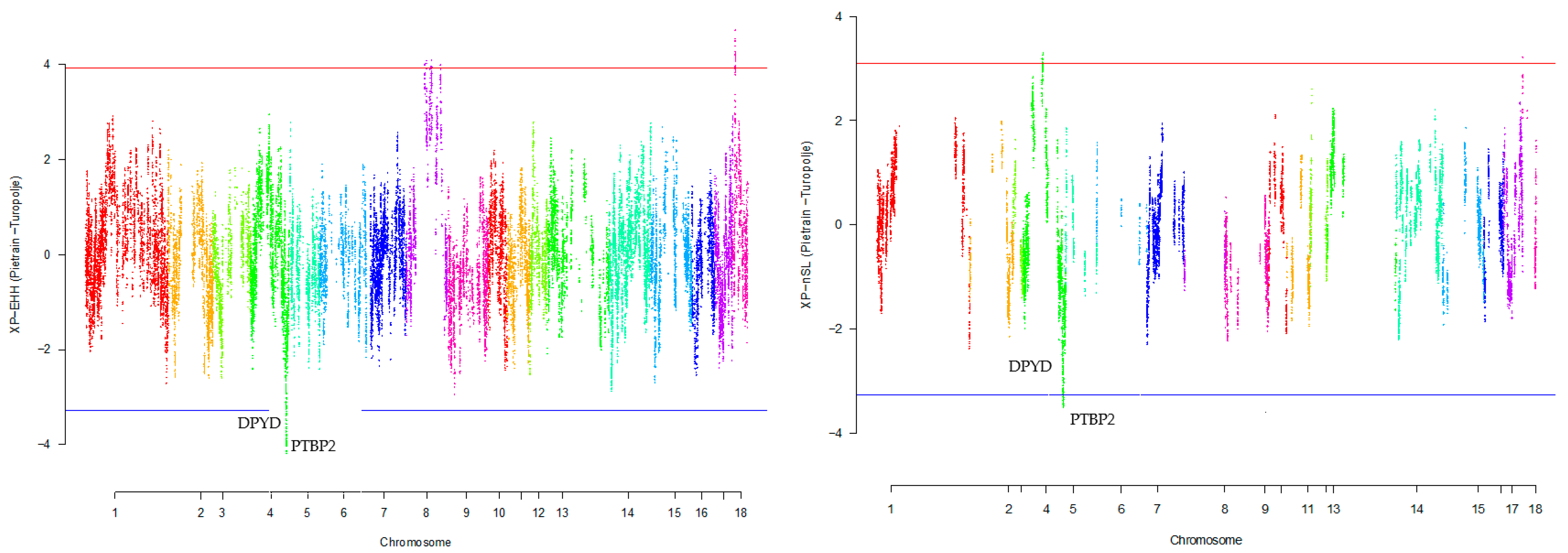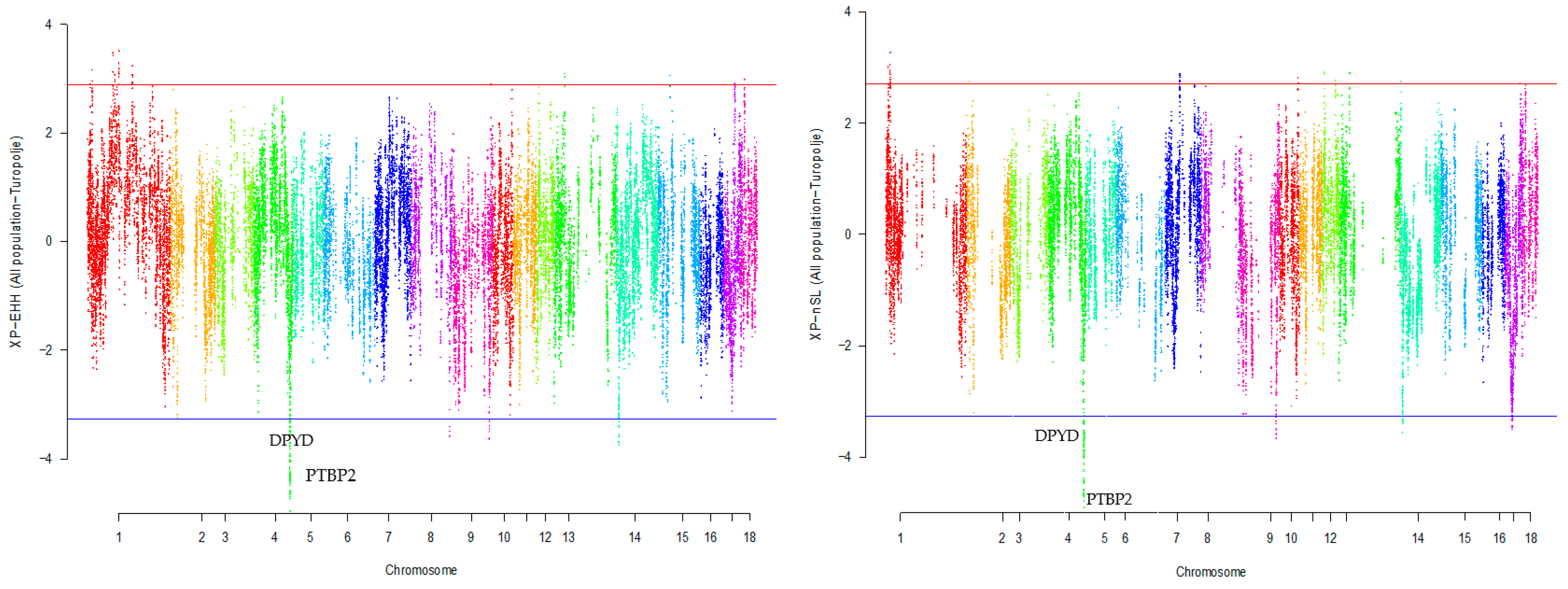Selective Sweeps in the Austrian Turopolje and Other Commercial Pig Populations
Abstract
:Simple Summary
Abstract
1. Introduction
2. Materials and Methods
2.1. Data
2.2. Methods
3. Results
4. Discussion
5. Conclusions
Author Contributions
Funding
Institutional Review Board Statement
Informed Consent Statement
Data Availability Statement
Acknowledgments
Conflicts of Interest
References
- Zhao, F.; McParland, S.; Kearney, F.; Du, L.; Berry, D.P. Detection of selection signatures in dairy and beef cattle using high-density genomic information. Genet. Sel. Evol. 2015, 47, 49. [Google Scholar] [CrossRef]
- González-Diéguez, D.; Tusell, L.; Bouquet, A.; Legarra, A.; Vitezica, Z.G. Purebred and Crossbred Genomic Evaluation and Mate Allocation Strategies to Exploit Dominance in Pig Crossbreeding Schemes. G3 Genes Genomes Genet. 2020, 10, 2829–2841. [Google Scholar] [CrossRef] [PubMed]
- Hermisson, J.; Pennings, P.S. Soft Sweeps: Molecular Population Genetics of Adaptation from Standing Genetic Variation. Genetics 2005, 169, 2335–2352. [Google Scholar] [CrossRef]
- Zanella, R.; Peixoto, J.O.; Cardoso, F.F.; Cardoso, L.L.; Biegelmeyer, P.; Cantão, M.E.; Otaviano, A.; Freitas, M.S.; Caetano, A.R.; Ledur, M.C. Genetic diversity analysis of two commercial breeds of pigs using genomic and pedigree data. Genet. Sel. Evol. 2016, 48, 24. [Google Scholar] [CrossRef] [PubMed]
- Sabeti, P.C.; Varilly, P.; Fry, B.; Lohmueller, J.; Hostetter, E.; Cotsapas, C.; Xie, X.; Byrne, E.H.; McCarroll, S.A.; Gaudet, R.; et al. Genome-wide detection and characterization of positive selection in human populations. Nature 2007, 449, 913–918. [Google Scholar] [CrossRef] [PubMed]
- Grossman, S.R.; Shylakhter, I.; Karlsson, E.K.; Byrne, E.H.; Morales, S.; Frieden, G.; Hostetter, E.; Angelino, E.; Garber, M.; Zuk, O. A composite of multiple signals distinguishes causal variants in regions of positive selection. Science 2010, 327, 883–886. [Google Scholar] [CrossRef] [PubMed]
- Eydivandi, S.; Roudbar, M.A.; Ardestani, S.S.; Momen, M.; Sahana, G. A selection signatures study among Middle Eastern and European sheep breeds. J. Anim. Breed. Genet. 2021, 138, 574–588. [Google Scholar] [CrossRef]
- Yang, W.; Liu, Z.; Zhao, Q.; Du, H.; Yu, J.; Wang, H.; Liu, X.; Liu, H.; Jing, X.; Yang, H. Population Genetic Structure and Selection Signature Analysis of Beijing Black Pig. Front. Genet. 2022, 13, 860669. [Google Scholar] [CrossRef]
- Szpiech, Z.A.; Novak, T.E.; Bailey, N.P.; Stevison, L.S. Application of a novel haplotype-based scan for local adaptation to study high-altitude adaptation in rhesus macaques. Evol. Lett. 2021, 5, 408–421. [Google Scholar] [CrossRef]
- Druml, T.; Salajpal, K.; Dikic, M.; Urosevic, M.; Grilz-Seger, G.; Baumung, R. Genetic diversity, population structure and subdivision of local Balkan pig breeds in Austria, Croatia, Serbia and Bosnia-Herzegovina and its practical value in conservation programs. Genet. Sel. Evol. 2012, 44, 1–9. [Google Scholar] [CrossRef]
- Szpiech, Z.A.; Hernandez, R.D. selscan: An Efficient Multithreaded Program to Perform EHH-Based Scans for Positive Selection. Mol. Biol. Evol. 2014, 31, 2824–2827. [Google Scholar] [CrossRef]
- Browning, B.L.; Tian, X.; Zhou, Y.; Browning, S.R. Fast two-stage phasing of large-scale sequence data. Am. J. Hum. Genet. 2021, 108, 1880–1890. [Google Scholar] [CrossRef] [PubMed]
- Kim, E.S.; Elbeltagy, A.R.; Aboul-Naga, A.M.; Rischkowsky, B.; Sayre, B.; Mwacharo, J.M.; Rothschild, M.F. Multiple genomic signatures of selection in goats and sheep indigenous to a hot arid environment. Heredity 2016, 116, 255–264. [Google Scholar] [CrossRef]
- Santana, M.H.d.A.; Ventura, R.V.; Utsunomiya, Y.T.; Neves, H.H.d.R.; Alexandre, P.A.; Oliveira Junior, G.A.; Gomes, R.d.C.; Bonin, M.d.N.; Coutinho, L.L.; Garcia, J.F. A genomewide association mapping study using ultrasound-scanned information identifies potential genomic regions and candidate genes affecting carcass traits in Nellore cattle. J. Anim. Breed. Genet. 2015, 132, 420–427. [Google Scholar] [CrossRef] [PubMed]
- Ding, R.; Yang, M.; Quan, J.; Li, S.; Zhuang, Z.; Zhou, S.; Zheng, E.; Hong, L.; Li, Z.; Cai, G.; et al. Single-Locus and Multi-Locus Genome-Wide Association Studies for Intramuscular Fat in Duroc Pigs. Front. Genet. 2019, 10, 619. [Google Scholar] [CrossRef] [PubMed]
- Zhang, X.; Lin, Q.; Liao, W.; Zhang, W.; Li, T.; Li, J.; Zhang, Z.; Huang, X.; Zhang, H. Identification of New Candidate Genes Related to Semen Traits in Duroc Pigs through Weighted Single-Step GWAS. Animals 2023, 13, 365. [Google Scholar] [CrossRef] [PubMed]
- Wu, S.; Guo, D.; Wei, H.; Yin, X.; Zhang, L.; Guo, B.; Xu, F.; Hao, Y.; Jiang, W.; Bi, H. Disrupted potassium ion homeostasis in ciliary muscle in negative lens-induced myopia in Guinea pigs. Arch. Biochem. Biophys. 2020, 688, 108403. [Google Scholar] [CrossRef]
- Yang, Y.; Wang, X.; Wang, S.; Chen, Q.; Li, M.; Lu, S. Identification of Potential Sex-Specific Biomarkers in Pigs with Low and High Intramuscular Fat Content Using Integrated Bioinformatics and Machine Learning. Genes 2023, 14, 1695. [Google Scholar] [CrossRef]
- Fontanesi, L.; Schiavo, G.; Galimberti, G.; Calò, D.G.; Russo, V. A genomewide association study for average daily gain in Italian Large White pigs1. J. Anim. Sci. 2014, 92, 1385–1394. [Google Scholar] [CrossRef]
- AL_Rayyan, N.; Wankhade, U.D.; Bush, K.; Good, D.J. Two single nucleotide polymorphisms in the human nescient helix-loop-helix 2 (NHLH2) gene reduce mRNA stability and DNA binding. Gene 2013, 512, 134–142. [Google Scholar] [CrossRef]
- Zhang, H.; Xia, P.; Feng, L.; Jia, M.; Su, Y. Feeding Frequency Modulates the Intestinal Transcriptome Without Affecting the Gut Microbiota in Pigs with the Same Daily Feed Intake. Front. Nutr. 2021, 8, 743343. [Google Scholar] [CrossRef]
- Bergamaschi, M.; Maltecca, C.; Schillebeeckx, C.; McNulty, N.P.; Schwab, C.; Shull, C.; Fix, J.; Tiezzi, F. Heritability and genome-wide association of swine gut microbiome features with growth and fatness parameters. Sci. Rep. 2020, 10, 10134. [Google Scholar] [CrossRef]
- Wang, X.; Li, G.; Ruan, D.; Zhuang, Z.; Ding, R.; Quan, J.; Wang, S.; Jiang, Y.; Huang, J.; Gu, T.; et al. Runs of Homozygosity Uncover Potential Functional-Altering Mutation Associated with Body Weight and Length in Two Duroc Pig Lines. Front. Vet. Sci. 2022, 9, 832633. [Google Scholar] [CrossRef] [PubMed]
- Hao, X.; Plastow, G.; Zhang, C.; Xu, S.; Hu, Z.; Yang, T.; Wang, K.; Yang, H.; Yin, X.; Liu, S.; et al. Genome-wide association study identifies candidate genes for piglet splay leg syndrome in different populations. BMC Genet. 2017, 18, 64. [Google Scholar] [CrossRef] [PubMed]
- Dervishi, E.; Bai, X.; Dyck, M.; Harding, J.; Fortin, F.; Dekkers, J.; Plastow, G. GWAS and genetic and phenotypic correlations of plasma metabolites with complete blood count traits in healthy young pigs reveal implications for pig immune response. Front. Mol. Biosci. 2023, 10, 1140375. [Google Scholar] [CrossRef] [PubMed]





| Breed Names | Chr | Genomic Region | XP-EHH | Chr | Genomic Region | XP-nSL |
|---|---|---|---|---|---|---|
| Large white | 1 | 147690556–148087719 | ZNF236, ZNF516 | 4 | 103963345– 105048775 | CD2, IGSF3, ATP1A1, MAB21L3, SLC22A15, NHLH2, CASQ2, VANGL1 |
| 4 | 102827190–105048775 | WDR3, GDAP2, TENT5C, MAN1A2, CD2, IGSF3, ATP1A1, MAB21L3, SLC22A15, NHLH2, CASQ2, VANGL1 | ||||
| 7 | 95365939– 95930034 | RGS6, DPF3 | ||||
| 8 | 136963965– 137878333 | CFAP299, FGF5, PRDM8, ANTXR2 | ||||
| 11 | 51339629– 51560305 | RBM26, NDFIP2 | ||||
| Duroc | 1 | 28566266 –107135517 | AHI1, MYB, HBS1L, ALDH8A1, MBD2, POLI, STARD6, C18orf54, DYNAP, ST8SIA3, ONECUT2, FECH, NARS1, MTFMT, SPG21, ANKDD1A | 1 | 27958270– 28302666 | PDE7B |
| 2 | 87322934 –88089403 | LHFPL2, ARSB, DMGDH, BHMT2, BHMT, JMY | 2 | 87614963– 137175305 | ARSB, DMGDH, BHMT2, BHMT, JMY, HOMER1, TENT2, CMYA5, MTX3 THBS4, SERINC5, C5orf15, VDAC1, TCF7, PPP2CA, CDKL3, UBE2B, CDKN2AIPNL, JADE2, SAR1B, SEC24A, CAMLG, DDX46, C5orf24, TXNDC15, CATSPER3 | |
| 14 | 93978255– 94102060 | ZWINT | ||||
| 15 | 55491087– 55681505 | DUSP4, TNKS | ||||
| Pietrain | 8 | 69771934– 116334013 | RASS, 6CXCL8, AMCF-II, PPBP, CXCL2, MTHFD2L, EPGN, INPP4B, IL15, RNF150, TBC1D9, ELMOD2, MGAT4D, CLGN, SCOC PPA2 | 18 | 59387007 –62455499 | ZFHX4, HNF4G, CRISPLD1, PI15, JPH1, LY96, TMEM70, UBE2W, STAU2 |
| 18 | 10268960– 12177267 | LUC7L2, FMC1, UBN2, TTC26, ZC3HAV1, ZC3HAV1L, KIAA1549, TMEM213, ATP6V0A4, SVOPL, TRIM24, AKR1D1, CREB3L2, DGKI | 4 | 9717294 –10234121 | TBXAS1, HIPK2, CLEC2L, KLRG2 | |
| Landrace | 1 | 206792212– 207495965 | CCDC171, PSIP1, SNAPC3, TTC39B | 14 | 49973938– 50184089 | IL16, STARD5 TMC3 |
| 7 | 57223851– 74975357 | PEAK1, HMG20A, LINGO1, ODF3L1, CSPG4, SNX33, IMP3, SNUPN, PTPN9, UBL7, SEMA7A, CYP11A1, CCDC33, STRA6, ISLR, ISLR2, PML, STOML1, LOXL1, TBC1D21, INSYN1, NPTN, REC114, HCN4, NEO1, ADPGK, BBS4, EGLN3, NPAS3, AKAP6, ARHGAP5, STXBP6, GZMB, GZMH, SDR39U1, KHNYN, CBLN3, NYNRIN, NFATC4, RIPK3, ADCY4, LTB4R | 7 | 100691955 –102597121 | LIPN, LIPM, ANKRD22, STAMBPL1, ACTA2, FAS, CH25H, IFIT3, IFIT1, IFIT5, SLC16A12, PANK1, KIF20B, HTR7, RPP30, | |
| 11 | 50730428– 50786774 | POU4F1 OBI1 | ||||
| Turopolje | 1 | 248604820– 248609035 | KLF4 | 4 | 119931414 121041802 | DPYD, PTBP2 |
| 4 | 119931414– 121041802 | DPYD, PTBP2 | 17 | 22635284– 25186703 | MACROD2, KIF16B | |
| 14 | 9197293– 10025164 | DOCK5, GNRH1, KCTD9, CDCA2, EBF2 |
| Comparing Breed and Methods | Common Genes | ||
|---|---|---|---|
| XP-EHH | XP-nSL | Between XP-EHH and XP-nSL | |
| Large White (Between two methods) | - | - | DPYD, PTBP2, ATP1A1, CASQ2, CD2, IGSF3, MAB21L3, NHLH2 SLC22A15, VANGL1 |
| Large White and Duroc | DPYD, PTBP2 | PTBP2 | PTBP2 |
| Large White and Pietrain | DPYD, PTBP2 | DPYD, PTBP2 | DPYD, PTBP2 |
| Large White and Landrace | DPYD, PTBP2 | PTBP2 | PTBP2 |
| Duroc (Between two methods) | - | - | ARSB, BHMT, BHMT2, DMGDH, JMY |
| Duroc and Pietrain | DPYD, PTBP2 | PTBP2 | PTBP2 |
| Duroc and Landrace | DPYD, PTBP2 | PTBP2 | PTBP2 |
| Pietrain (Between two methods) | - | - | DPYD, PTBP2 |
| Pietrain and Landrace | DPYD, PTBP2 | PTBP2 | DPYD, PTBP2 |
| Landrace (Between two methods) | - | - | PTBP2 |
Disclaimer/Publisher’s Note: The statements, opinions and data contained in all publications are solely those of the individual author(s) and contributor(s) and not of MDPI and/or the editor(s). MDPI and/or the editor(s) disclaim responsibility for any injury to people or property resulting from any ideas, methods, instructions or products referred to in the content. |
© 2023 by the authors. Licensee MDPI, Basel, Switzerland. This article is an open access article distributed under the terms and conditions of the Creative Commons Attribution (CC BY) license (https://creativecommons.org/licenses/by/4.0/).
Share and Cite
Atrian-Afiani, F.; Berger, B.; Draxl, C.; Sölkner, J.; Mészáros, G. Selective Sweeps in the Austrian Turopolje and Other Commercial Pig Populations. Animals 2023, 13, 3749. https://doi.org/10.3390/ani13243749
Atrian-Afiani F, Berger B, Draxl C, Sölkner J, Mészáros G. Selective Sweeps in the Austrian Turopolje and Other Commercial Pig Populations. Animals. 2023; 13(24):3749. https://doi.org/10.3390/ani13243749
Chicago/Turabian StyleAtrian-Afiani, Farzad, Beate Berger, Christian Draxl, Johann Sölkner, and Gábor Mészáros. 2023. "Selective Sweeps in the Austrian Turopolje and Other Commercial Pig Populations" Animals 13, no. 24: 3749. https://doi.org/10.3390/ani13243749





